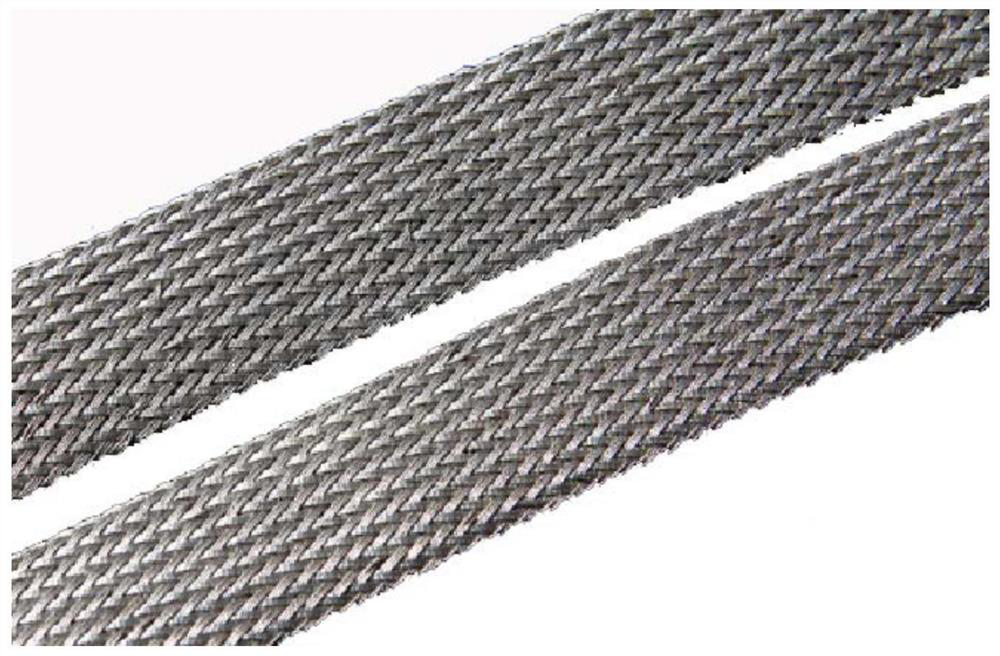Light metal wave-proof sleeve and preparation method thereof
An anti-wave sleeve and metal technology, applied in the field of anti-wave sleeve, can solve the problems of weight reduction of the anti-wave sleeve, and achieve the effects of controlling the braiding tension, improving the mechanical strength and high tensile strength
- Summary
- Abstract
- Description
- Claims
- Application Information
AI Technical Summary
Problems solved by technology
Method used
Image
Examples
preparation example Construction
[0024] The present invention also provides a kind of preparation method of above-mentioned light-duty metal wave-proof cover, and this preparation method comprises:
[0025] 1) After the aluminum alloy raw material is heat-treated at 500°C-550°C, it is vacuum degassed, vacuum hot-pressed, hot-extruded with a mold, cooled, and then cold-pressed to form an aluminum alloy wire;
[0026] 2) subjecting the aluminum alloy wire to activation treatment, followed by copper plating treatment and nickel plating treatment to obtain nickel-plated copper aluminum alloy wire;
[0027] 3) The nickel-plated copper-aluminum alloy wires are paralleled, and then braided on a double-rotary braiding machine to obtain a light-weight metal anti-wave sleeve.
[0028] In the above preparation method, the mode of activation treatment can be selected in a wide range, but in order to further improve the activation effect, preferably, the activation treatment is dipped in 4-6% by weight of dilute sulfuric ...
Embodiment 1
[0033] 1) After the aluminum alloy raw material is heat-treated at 530°C, it is vacuum degassed, vacuum hot-pressed, hot-extruded with a mold, cooled, and then cold-pressed to form an aluminum alloy wire;
[0034] 2) The aluminum alloy wire is subjected to activation treatment for 25 minutes (impregnated with 5% by weight of dilute sulfuric acid), followed by copper plating treatment and nickel plating treatment to obtain a nickel-plated copper aluminum alloy wire with a diameter of 0.12 mm, and the thickness of the copper plating layer is 0.25 mm. μm, the thickness of nickel plating layer is 0.8μm;
[0035] 3) Parallel the nickel-plated copper-aluminum alloy wires (by a doubling machine), and then weave them on a double-rotary braiding machine to obtain a light metal anti-wave sheath with a weaving density of 95%.
Embodiment 2
[0037] 1) After the aluminum alloy raw material is heat-treated at 500°C, it is vacuum degassed, vacuum hot-pressed, hot-extruded with a mold, cooled, and then cold-pressed to form an aluminum alloy wire;
[0038] 2) The aluminum alloy wire was activated for 20 minutes (impregnated with 5% by weight of dilute sulfuric acid), followed by copper plating and nickel plating in order to obtain a nickel-plated copper-aluminum alloy wire with a diameter of 0.10 mm, and the thickness of the copper plating layer was 0.2 mm. μm, the thickness of nickel plating layer is 0.6μm;
[0039] 3) Parallel the nickel-plated copper-aluminum alloy wires (by a doubling machine), and then weave them on a double-rotary braiding machine to obtain a light-weight metal anti-wave sheath with a weaving density of 98%.
PUM
| Property | Measurement | Unit |
|---|---|---|
| thickness | aaaaa | aaaaa |
| thickness | aaaaa | aaaaa |
| diameter | aaaaa | aaaaa |
Abstract
Description
Claims
Application Information
 Login to View More
Login to View More - R&D
- Intellectual Property
- Life Sciences
- Materials
- Tech Scout
- Unparalleled Data Quality
- Higher Quality Content
- 60% Fewer Hallucinations
Browse by: Latest US Patents, China's latest patents, Technical Efficacy Thesaurus, Application Domain, Technology Topic, Popular Technical Reports.
© 2025 PatSnap. All rights reserved.Legal|Privacy policy|Modern Slavery Act Transparency Statement|Sitemap|About US| Contact US: help@patsnap.com


